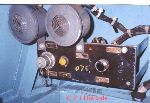 |
Buzzers: These Buzzers buzz when ever there is load parting. The yellow
colored indicator (LSPAR) comes on. Right next to this indicator is a 110 Volts outlet socket.
At the moment it is covered with a cap that is chained to the socket itself. The green colored
switch (BIS) is the resetting switch used to silence the buzzers once things are set right. |
 |
That's the color code of the brake pipes, to prevent any interchange or wrong connections.
It's painted on the inside wall over the wind shield of the cab. |
 |
Cab heater and Fire extinguisher |
 |
A view of the RHS corner of the loco control desk:
- "A" Horn valves: The horn is pneumatic and these are the valves that have
to be pressed to blow horns. Two valves - one for the front and the other for the rear.
- "B" Emergency brake flap: A flick of the lever that holds the flap down
and the flap is off its seat. Brake pipe pressure is lost and the train screeches to a halt.
- "C" flasher light control unit: More details of it latter on in another
picture.
- "D" Marker lamps control unit: There are marker lamps at both the ends of
the loco and these are either yellow or red depending on the direction the loco is
traveling. Obviously the marker at the front is yellow and the one at the rear red.
|
 |
A view of the central portion of the control desk:
- NR2 is the notch indicator.
- ZPT2 is the switch used to lower, raise and select the panto to be
raised.
- ZLC1 and ZLC2 are switches used to switch on and off
the lights in the cab.
- BPISX is the red colored switch used to flash the green colored
lamps located on the outside wall of the cab on the side top corners. The WAP 4 is a
high speed loco and many a times these lamps are used to exchange the " All Right"
signal with the ASM and other ground staff.
|
 |
The switch board and the indicator lamps module located in the driving cab. |
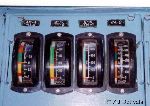 |
Ammeters & Voltmeters:
- AM4 TM4: This ammeter indicates the current flowing through Traction
motor no. 4. A WAP 4 loco may draw a max current of 1000 Amps for a max duration of 10
minutes. Current of 900 Amps may be drawn continuously.
- U-5 TM-5: This volt meter indicates the voltage across Traction motor
no. five. The voltage at no time should exceed 750 voltage. When a quick acceleration
is required and if the voltage exceeds 750 volts due to rapid increase of notches, the
shunting notch (weak field lever or the "MPS") may be put into position one after notch
20. This will lead to an increase in the amps across the traction motors but a reduction
in the voltage across it. The notches may than be increased and again if the voltage
goes up the shunting notch may be put at position two.
- U-6 TM-6: This voltmeter indicates voltage across Traction motor six.
Old timers may wonder as to why there are two voltmeters and only one ammeter, because
there used to be two ammeters and one volt meter in all loco upto now. The reason is
that now, higher than permissible voltage across the TM's for burnt out of TM's.
|
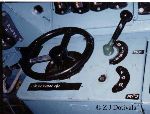 |
- The round steering like thing is used to increase the notches.
- The MPJ lever is used to change the running direction of the loco viz reverse or forward.
- The MPS lever is the shunting notch or the weak field lever. This is
brought into operation to prevent voltage across traction motors from increasing beyond
750V. This enables rapid acceleration as more notches can be open as the voltage drops and
also the TMs speed up due to weakening of the field.
|
 |
These days trains are run at Max speeds. Drivers are instructed to drive in "air brake style"
This involves rapid acceleration and equally rapid & frequent breaking. To ensure that the
loco can accelerate immediately after brake application, brake release must be immediate. Or
time is lost as the driver waits for brakes to release(Impatient drivers have been known to
end up with fractured couplers). The Green colored switch shown here, when pressed results in
immediate brake release. The Buzzer and LED shown here come on in case of load parting. The
other green colored switch is to reset the buzzer after the "All Right" signal is given. |
 |
A view of the LHS corner of the cab:
- "A": A9 , train brakes
- "B": SA 9, Loco brakes
- "C" Speedometer. Now a days we have modified speedometers that record
speed on floppy instead of graph paper.
- "D": Air flow meter. This indicates the flow of brake air
- "E": Ash tray. I have come across it the first time. Has IR started
encouraging smoking among staff and crew ?
- "F":Valves / switches to blow horn
- "G": Gauges to indicate brake air pressure.
|
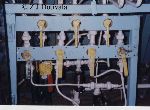 |
Cut out valves: These valves are situated in the lower LHS corner of the
loco. One can cut out air to the various pneumatic equipment in the loco. There are two valves
for SA9, two valves for SA9 , one for the wiper and two for the horns. |
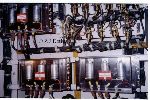 |
These are the capacitors for the Arno and compressor. These are located in a cabinet on the
back wall of the cab. |
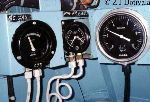 |
A close view of the brake air pressure gauges situated in the extreme LHS corner of the cab.
The gauge with the two coiled pipes connected to it shows the main reservoirs pressure and the
feed pipe pressure. The larger gauge with graduations from 0 to 10 shows the air pressure in
the brake pipe. |
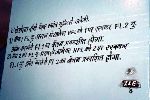 |
ZLE3 is the switch for the light in the compartment on the back wall of the
cab that houses the capacitors for the Arno and compressor.
There are two flashers outside the
cabs. One on each cab. There are two control units, one in each cab for controlling the
flashers. Normally one unit controls one flasher If any one of these flasher units fails than
the other unit can control the flashers irrespective of their location.
The writing on the wall reads: If the switch is on "0" position both flashers
will run individually on independent units. If the flasher unit in cab one malfunctions than
the HFL should be put on position "1" Now if the flasher unit in cab two is switched on it will
run the flasher located on cab one. If the flasher unit located in cab two malfunctions than
HFL should be put on position "2" and flasher unit located in cab one will run the flasher unit
located on top of cab two. |
 |
When ever a loco crosses a dead zone the "DJ" has to be opened as a result of this all
electrical in the loco including the head light gets switched off. To avoid this a DC-DC
Converter is being retrofitted in locomotives. These converters step down the 110 volts from
the batteries in the loco to 32 volts which is than supplied to the head light when ever the
loco is passing a dead zone. What is shown in this pic is merely the control unit for this
converter, there are other transformers which actually do the converting and they can be seen
in another pic. |
 |
This is the VB box. This is a safety device (interlock box) to ensure that OH supply is
switched off before a human enters the interior of the loco. The large socket takes in the
ZPT key. The keys numbered one to four are the fitchet keys. |
 |
The battery charger. |
 |
This is the GR handle. The notches can be manually increased from here. |
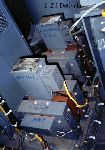 |
The transformer that steps down 110 volts from the batteries to 32 volts. This is supplied to
the head lamps when ever the loco crosses a dead zone. |
 |
This is the contactor for the GR. One can see the thin wire like things behind. These are
resistors that come into play when the notches are increased. |
 |
Smoothening reactors: The loco takes in AC from the OHE. This has to be
converted to DC before being fed to the traction motors. The main rectifier does this job.
But the out put of the rectifier is not pure DC when connected to a CRO it does not give a
100% smooth straight line. To rectify this the smoothening rectifiers are employed. They
smoothen the out put of the rectifiers rendering pure DC out put. |
 |
The Pump that circulates the oil in the main transformer to keep temperature under control. |
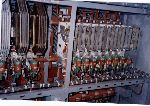 |
Resistance contactors and line contactors. |
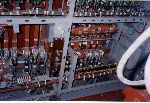 |
"A": That's the loco reversing contactor. |
 |
"A": That's the DJ main contactor. It's something like a "AB" switch. When in open position it isolates the loco from OHE. The DJ has to be opened whenever the loco crosses a dead zone. |
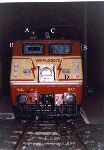 |
Front view of the loco:
- "A": Flasher lamp.
- "B": Green colored indicator lamps used to exchange signals with ground
crew.
- "C": Horn.
|
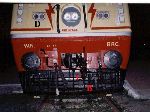 |
Lower front view of the loco:
- "A": A metal strip about three inches wide to protect the FP and BP valves
when there is a cattle hit.
- "B": Cow catcher.
- "C": Auxiliary air reservoir.
- "D": Marker Lamp.
|
 |
- "A": "Skid" A metallic wedge to prevent the loco from rolling away
when parked.
- "B": The Bogie. WAP 4 has a cast iron bogie.
|
 |
A view of the DJ main contactor from the other side. |
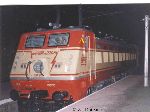 |
A front full view of the Majestic WAP 4 from Vadodara at Badnera. This loco had come to
Bhusaval for It's POH. When ever locos under go POH they have a first trial run. They are made
to haul lightly loaded passenger train. A WAM 4 is right behind this loco just waiting to
take over in case the newly overhauled loco acts up. "A": This is the green
colored signaling lamp. This is used to exchange signals with ground crew when the loco runs
at high speeds.
|

